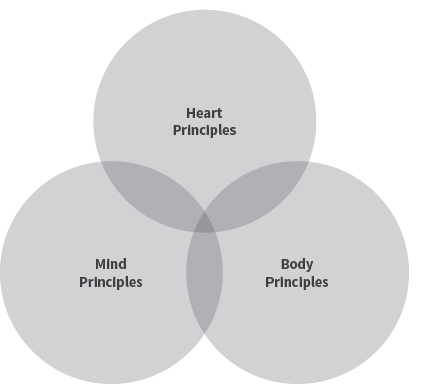9

CHAPTER 9 REFINE
“The whole of science is nothing more than a refinement of everyday thinking.”
Albert Einstein1
Refine means to improve or clarify by making small changes, removing unwanted elements. There is also something in the word refinement that points to a subtle elegance and sophistication.2
To refine thinking and actions is part of the learning cycle captured by David Kolb in his theory of experiential learning.3 Through the process of reflecting described in Chapter 8, Impact, we can gain greater insight and understanding into our core values and the activities or practices that best demonstrate these values in practice.
Refining is about making small changes, based on what you are learning from the evidence you are collecting. This adaptive action builds capacity to see, understand and influence systems and is the fourth pillar of the 31Practices methodology. The adaptive action cycle described in Human System Dynamics is essentially what “refinement” is about within the 31Practices methodology. There are three simple questions:
• What? What patterns are you now seeing, what is the data and information that you have?
• So what? What does the data mean – what are the options for actions that can be taken on the basis of the data?
• Now what? Take action and observe the impact it now has.4
The process of refinement is one of becoming clearer about your core proposition, what you stand for and how you want to operate. Something that is ultimately refined offers a sense of flawless quality, polished and artful.5
Refinement is core to any process of continuous improvement, or quality. From his work on the P(lan), D(o), C(heck), A(ct) cycle, Deming stressed the importance of constant interaction among design, production, sales, and research and that the four steps should be rotated constantly, with quality of product and service as the aim.6 Deming described his “Deming Wheel” – which we have altered slightly to fit with 31Practices:
• Design the 31Practices framework and content (with appropriate tests).
• Make it and test it: live as well as in theory.
• Put it out into the organization.
• Keep testing it, gather feedback, gather as much data as you can, find out what stakeholders think and why those who are not persuaded have not “bought it”.
• Refine the framework and its application, in the light of stakeholder reactions.
Continue around and around the cycle – growing and moving closer towards your purpose with each turn.
Early on in our work in organizations, when Total Quality Management was the new shade of black and embraced with energy in the manufacturing sector, the beef from employees at different levels would be the rigidity of some of the quality processes introduced, and the difficulty of testing and integrating improvements and innovations into the existing system. This very point has echoes with the experiences of those who have really embedded Continuous Improvement processes into their systems such as Motorola and GM. For example, 3M, a company renowned for innovation, had to loosen its sigma methodology in order to increase the flow of innovation.7
As innovation thinker Vijay Govindarajan notes, “The more you hardwire a company on total quality management, [the more] it is going to hurt breakthrough innovation. The mindset that is needed, the capabilities that are needed, the metrics that are needed, the whole culture that is needed for discontinuous innovation, are fundamentally different.”8
Finding the balance between a clear structure and process for people to follow, and flexibility and adaptiveness to what is new and emerging is important to consider.
Rob Ashkenas suggests bearing three principles in mind.
• What’s pragmatic here? What needs customizing to be fit for purpose? What level of discipline is really needed in the review process? What’s required in a manufacturing or food-based environment is likely to be overkill in a design or service environment.
• What’s the purpose of the “rule” here? Is the rule still fit for purpose, should some things be eliminated rather than improved?
• What’s the impact on the culture? The way things are done around here.
While Ron Ashkena’s focus is about enabling breakthrough innovation within a continuous improvement environment, the points apply to the refinement process in general.9
The strength of 31Practices is that there is a consistency of direction provided by the purpose, core values and daily Practices but, importantly, the people in the organization are able to test and adjust their specific actions to add most value. This ongoing refinement on a daily basis needs to be mirrored through keeping the 31Practices framework alive, meaningful and above all useful.
REFINING YOUR 31PRACTICES FRAMEWORK – BUILDING YOUR APPROACH
Designing how you are going to refine your organizational 31Practices is an important part of the process.
You will be pleased to hear that typically, unless there is a fundamental change in your governance structure (as a result of a merger and acquisition process, for example), or there is a fundamental shift in your stakeholder market due to a brand repositioning exercise, your core values are unlikely to change significantly – assuming you have had the right conversations to identify them in the first place.
There is no fixed way to refine your 31Practices framework. Your core values and Practices, and your purpose, are unique to you. However, there are some principles that you should consider:
New user or business as usual – where are you?
If you have just started using 31Practices, like any systemic change process, keeping a closer eye on the implementation, take-up and impact of the framework is going to be important to ensure timely attention to what is emerging during this period of greater ambiguity and uncertainty.
Employees, from the CEO to the security guard, are going to be feeling slightly unsure about the changes and what is required of them even when they are wholly enthusiastic. Some employees will be openly resistant. What level of focus and reassurance is required to enable people to trust that 31Practices will work to support the organization to deliver its purpose? What trusted individuals, deeply familiar with 31Practices, are going to have access to all areas during this initial phase to provide quick answers to questions, ask the questions that others are afraid of asking, challenge assumptions that might be made and provide guidance to the process? What has worked for you in the past when introducing any systemic change?
In the first 3 months, some evidence-based testing is recommended. Once embedded, a six-monthly or annual “refinement” or review is suggested to ensure the appropriate level of attention to effective operation.
Values-led process – what kind of refinement process fits with the values you are practising?
In the 31Practices framework, the core values are central to decision making and give insight into the “way things are done around here”. Embody the core values and Practices in the way that you create and enable the review process. For example, if one of your values is innovation, how do you enable innovation in the refinement process? If one of your values is integrity, what integrity does your review process have?
Evidence-based refinement – what data do you need to have to hand?
What is the data that you are going to draw on to review how effective 31Practices has been? Looking at ideas around evidence-based practice and management,10 it’s important to pay attention to four areas of data:
• What data do you have from external stakeholders, from customers and suppliers, shareholders?
• What data do you have from leaders and managers in the business, from the systems and processes that were included as part of the operating platform for 31Practices?
• What data can you draw on from the broader context, the market niche, market share?
• What data do you have from your other employee groups?
Study the data. What has emerged, and what was expected? Here you are looking at both “how” things are working as well as “what” is working /not working. What needs adjusting to improve how things are implemented or supported? What needs adjusting in terms of the detail of the values/Practices articulated?
Sharing and involvement – warts and all.
Providing feedback into the organization about the review process, what has been “heard”, what is working, what is changing, is key to the process of refinement. We have also found that sharing the stories and modelling learning at all levels of the organization is beneficial. In this way, 31Practices becomes owned by everybody in the organization and perhaps surprisingly, even a little vulnerability from the leadership team will support others to change and grow.
“Learning is not compulsory; neither is survival”
W. Edwards Deming11
Exercise:
We share a really simple exercise here to support you to refine actions and behaviours in order to get a different impact. This exercise, known as “start, stop, continue” is one that can be done by yourself – focusing on your individual behaviours and at a team or system level.
Simply share:
• Three things you feel you (the team, the organization) should start
• Three things you feel you (the team, the organization) should stop
• Three things you feel you (the team, the organization) should continue
Want to know more?
• Shewhart, Walter Andrew (1980). Economic Control of Quality of Manufactured Product/50th Anniversary Commemorative Issue. American Society for Quality.
• Gerald J. Langley, Ronald Moen, Kevin M. Nolan, Thomas W. Nolan, Clifford L. Norman, Lloyd P. Provost (2009). The Improvement Guide: A Practical Approach to Enhancing Organizational Performance, (2nd Edition). San Francisco: Jossey-Bass.
• Deming, W. Edwards (1986). Out of the Crisis. MIT Center for Advanced Engineering Study.

